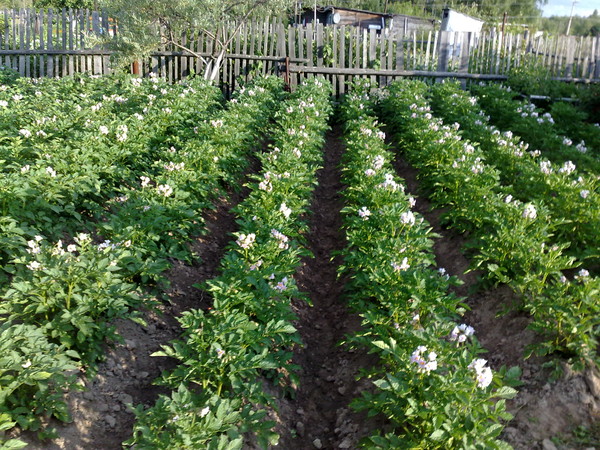 Each summer resident or person who has a garden grew potatoes. Perhaps this is the most popular vegetable crop both for planting and for eating. However, no matter how long they have studied and practiced in planting, it would seem understandable to vegetable culture, it still does not always work to collect a decent crop.
Each summer resident or person who has a garden grew potatoes. Perhaps this is the most popular vegetable crop both for planting and for eating. However, no matter how long they have studied and practiced in planting, it would seem understandable to vegetable culture, it still does not always work to collect a decent crop.
One of the reasons may be the large tops of potatoes. Let's talk about this problem and see what exactly contributes to the increase of green leaves and how to deal with it.
As you know, all potato tops are of no use to a person, because they are not suitable for human consumption. However, this part is indispensable when creating high-quality organic fertilizers. Usually it goes through composting or burning to ash. In addition, it is the tops that are used in both folk and pharmaceutical medicine to create pest control products.
Unfortunately, potato tops very badly affect the potato harvest. Experienced gardeners have tested in practice that the larger the tops of potatoes, the worse and less will be the yield of vegetables. This is due to the fact that the plant devoted all of its natural "strength" to the growth of greenery, but not to the development of tubers. Although, it is worth noting that this dependence is not always confirmed and depends on many factors.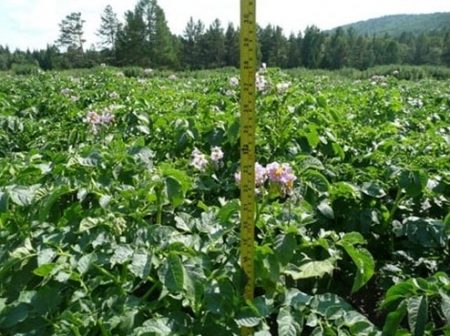
In our so-called “rating”, an excess of nitrogen is the first reason for the growth of greenery. Such a problem can arise in the case when the gardener, for good and good reasons, went too far with the amount of fertilizer. They contribute to the rapid and violent increase in the green part of the vegetable without the desired increase in tubers. Due to an excess of nitrogen, potato tops can grow more than a meter in height, but, unfortunately, without increasing the number or volume of root crops.
If, due to nitrogen, the tops are significantly increased, you can affect the further development of root crops. This will help change fertilizers. The best and most effective solution will be the introduction of superphosphate into the "diet" of potatoes. Superphosphate, as a rule, does not affect the reduction of tops, but it favorably affects the potato fruit. On the scientific side, this type of fertilizer accelerates the process of “aging” of the fetus and stimulates a vivid outflow of substances necessary for growth or tops to root crops.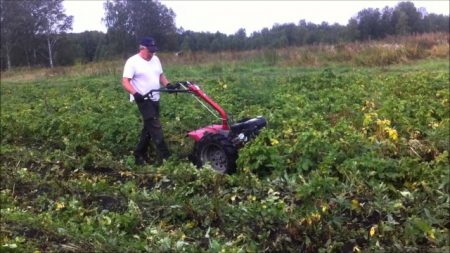
In order to prepare this type of fertilizer at home, it is necessary to mix superphosphate with warm water in a proportion of 1 liter of water per 10 g of active substance. The resulting solution must be evenly distributed over all areas of the planted potato. To process two hundred square meters of land, it is recommended to make 20 liters of such a solution.
In order not to repeat such mistakes in the future, it should be remembered that additional enrichment of the earth with nitrogen is not required if manure or humus was used in the form of fertilizer during the preparation of future beds.
It is worth remembering that potatoes are an independent vegetable that does not require an excess of fertilizers. After all, if both the tops and tubers are successful, thanks to fertilizers, potatoes can be poorly preserved and soon the abyss. Experienced gardeners recommend carrying out any dressing strictly according to the instructions and say that it is better to reduce the amount of fertilizer.
It is from noble intentions, especially the beginning gardener, who sits large or even huge tubers. However, this is very bad for further harvest. The larger the size of the tuber was planted, the proportionally more nutrients. This favorably affects the green part of the potato, but not the tubers.As in the case of an excess of nitrogen, due to the large leaves, the fruits themselves develop very slowly, which will not bring the desired result.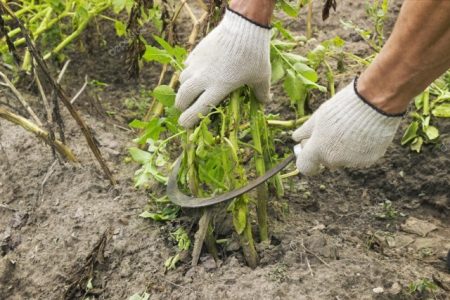
When the growth of the vegetative part ends, and the plant should develop precisely the tubers. This does not happen, since the development of the fetus has practically stopped due to the end of the growing season, and the potato itself did not have time to develop.
In order not to make the same mistakes in the future, experienced gardeners strongly recommend choosing a vegetable for planting that does not exceed the size of a chicken egg.
Perhaps the most common problem due to which a high leaf top grows is the lack of natural light. Everyone who has ever encountered seedlings in the country or in the private sector has observed a trend that is directly dependent on light. If the sprouted tops of the tops are not enough light, they begin to “stretch” closer to the sun. That is why in the shade, potatoes will grow with greens, but not tubers.
A similar effect will be when saving space and the location of potato beds too close to each other without adhering to the established distances. Potato - this is exactly the plant that does not allow saving space. In a forced discomfort, the vegetable begins to give all its vitality to the tops, fighting for a place in the sun.
There is another outcome of saving space - the defeat of potatoes with various fungal diseases, which are difficult and long to fight. This is due to insufficient air exchange on the established beds.
Only in the southern regions does the problem of lack of light do not arise, and even in the shady floor. It is in these regions, even with high tops, large potatoes grow.
If gardeners are to blame for the excess nitrogen, the planting of large tubers and the close proximity of the beds, then a person cannot influence the weather conditions. After all, it is in the warm, slightly rainy summer that any grass, like the tops of potatoes, grows by leaps and bounds.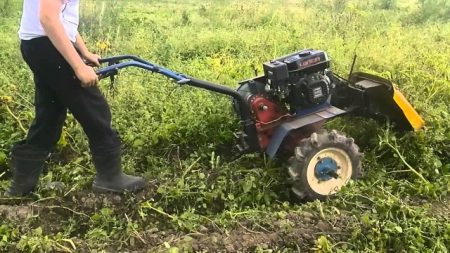
Any gardener can not predict the weather conditions and therefore you can save the crop only in one proven way. After the potatoes have bloomed, wait a few days, or rather a week, and stamp the tops to the level when it does not cover the whole earth. So she will not be able to take the remaining necessary substances from the tubers and grow even more. As a result of such a simple action, all the energy for growth will be transferred to nascent tubers, giving the gardener a rich and desired crop.
Before embarking on seedlings of any vegetable crop, be it potatoes or tomatoes, it is necessary to understand the plant's life cycle and the principle of caring for it. This will help prevent the appearance of various diseases, avoid the appearance of a large number of pests and get the desired crop. Potato is precisely that vegetable that is not too picky in care, and it is from it that beginner gardeners and gardeners begin to learn the garden craft.
As if it weren’t just landing, you need to know some subtleties so as not to be left without your favorite vegetable. One of the points that must be controlled is the growth of potato tops (exceeding 80 cm in length). If the tops are just beginning to actively pick up greens, then you need to determine the cause and take some measures.
If the tops are more than one meter, then this is the main sign of a high nitrogen content in the soil. As described previously, it is necessary to adjust the quantity and frequency of fertilizers, as well as prepare a solution of superphosphate. Of course, the amount of tops from this will not decrease, but it will stop noticeably and all the nutrients will be given to the tubers.
If you want to avoid this problem in advance, you must first draw up the correct fertilizer schedule. It should look something like this:
- the first time the application of fertilizer should be no earlier than the first shoots of greenery appear.
- Fertilizers based on ammonium nitrate or urea are recommended. The solution is diluted at the rate of 15 liters of water per 15-20 g of active substance. However, remember that during the initial treatment, in autumn or spring, do not use any fertilizer to increase nitrogen in the soil.
- Further feeding is carried out only after hilling. The second time they are fertilized only after reaching 25 cm of greenery. Nitrofosks are usually used, scattering 25 g between potato beds. Having a good second feeding, further fertilizers are not needed.
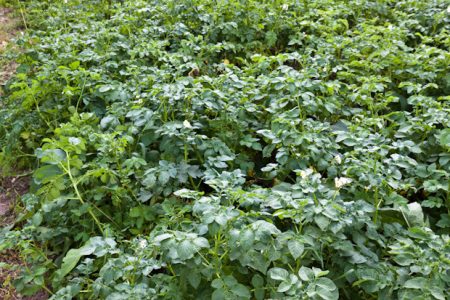
Usually in summer, experienced gardeners feed the earth with various nutrients, doing foliar top dressing. However, it is worth remembering that foliar top dressing needs to be combined with spraying from insects.
No matter how strange it sounds, but the big tops are mainly the merit of gardeners only. From good intentions, or from ignorance in the early years, I want to do my best to get large, dense tubers of potatoes. But in the pursuit of the desired result, most often it turns out the opposite - a poor harvest and a lot of greenery.
In order to avoid such a fate, it is necessary to remember the basic recommendations for planting and leaving potatoes. Here are the basic landing rules:
- the size of potatoes for planting does not exceed the size of a chicken egg;
- at the time of planting, the soil should be warmed not less than 12-15 degrees Celsius;
- it is necessary to fertilize potatoes strictly according to the instructions so as not to “overfeed” it;
- when planting, the distance between the holes should be 25-30 cm.
Of course, these are not all the rules, but without following these recommendations, the tops will grow, and the yield will be scarce.
As the practice of experienced gardeners shows, the height of the tops does not always affect the future crop. This is because different varieties of potatoes behave differently during growth. In order to accurately determine the norm of future leaves, it is necessary to study the variety desired for planting and establish “for yourself” the boundaries of the acceptable level of care.
For example, potato varieties such as Nakra and Adretta possess rather high tops. For them, a bush of 50-80 cm tops will be normal. It is worth worrying only in those cases when the greens sharply began to grow on the variety of potatoes you know, although this should not be.
Of course, not the only problem with the tops is the abundance of greenery. It happens, when on the contrary, the tops are not enough and this causes even greater fear.
If you are planting this type of potato for the first time, then you should not worry ahead of time, namely, until the first harvest. As mentioned earlier, each variety behaves differently, and what is the norm for some, for other varieties, may well be a deviation. The characteristics of each species are radically different and there are species where greens never exceed 40-50 cm.
However, this does not mean that they have less yield. In some types of potatoes, where the greens do not grow to enormous sizes, you can get up to 25 units of potatoes from one bed at a time. Potatoes of the “Red Scarlett” variety can be attributed to this type. However, even such a well-known and popular potato variety as "Luck" is not famous for its rich greens. Small tops are only a feature of the variety, but not a defect or problem, but only if you know that it should be so.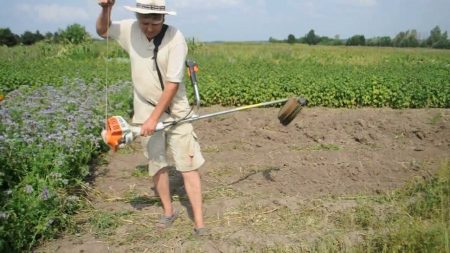
If you know that there should be more leaves, that it is necessary to take operational actions to save the crop. Most often, the underdevelopment of tops is associated with a deficiency of phosphorus in the soil. This leads to a decrease or even loss of yield.
In order to verify the correctness of the “alleged diagnosis”, it is necessary to perform a simple action: dig one, the least developed bed in order to check the tubers.After you have removed one potato tuber from the ground, cut it in half. If you see that the potato has a purple hue inside - this means that the soil is depleted in phosphorus and fertilizers need to be introduced.
For example, it nourishes the soil and the above superphosphate. However, there is a significant difference: it is necessary to cultivate not the soil, but the leaves. This is how you can reanimate potatoes and directly enrich them with phosphorus.
So, do not worry too much about the lack or excess of tops. Remember that each variety behaves differently and needs some care. Do not immediately buy up all the fertilizers and water with everything you see. Give the potatoes a break and you will see a wonderful result.
Be that as it may, the question arises: is it necessary to mow potato tops? Even 50 years ago there was not even a question about mowing or cutting tops, because potatoes grew almost without human intervention. Only watered, if necessary, and processed from Colorado beetles. Well, the final stage was digging up potatoes with large tubers.
After some time, gardeners began to cut the tops for the sake of the experiment, but it was cut only before digging it, and most likely, just for convenience. On the one hand, it’s easier to dig out, because the greens do not interfere, and on the other hand, this is unnecessary work, loss of time and energy, and as a result, the beds are also less visible. Some sources still recommend mowing tops before harvesting.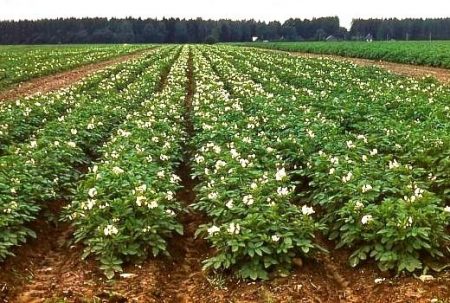
Today, the tops are cut and burned without fail in order to preserve the future harvest. This is due to the fact that it is in a seemingly ordinary greenery that such a “disease” as late blight remains. With a simple mowing and the usual instillation, the phytoptop will go into the soil and adversely affect the future potato harvest. This disease can only be eradicated by burning.
Only after all the potato grass has been mowed, do nutrients pass directly into the tubers, thereby allowing the tubers to ripen better.
In order for the peel of your favorite vegetable to be denser, a cut of tops will contribute to this. After mowing, the fruit is still in the ground for several days, enriched with useful minerals.
However, if you cut the tops in no case, you can not immediately dig up potatoes. This leads to rapid rotting of the potato and further cracking of the fetus.
Based on the literature for summer residents, it is recommended to harvest the tops about a week before the expected harvest. Some recommend giving the fetus "rest" for about two weeks, but only you decide.
It still depends on the variety of potatoes, because each variety requires collection at a certain time. Most often collected in late August - early September. Previously, it is not recommended to collect, due to the fact that the tubers have not yet developed sufficiently. It is best to start digging out only after the tops are completely dead. However, even later it is not recommended that the potato does not start to re-let the leaves, giving the last effort to restore the bush.
If the tops have already died out, then do not delay with excavation. A maximum can be kept potatoes in the ground 3 weeks after dying. Otherwise, the quality of the tubers will decrease and the potatoes will not overwinter.
Reviews
Natalia, Petropavlovsk:
“I planted potatoes for the first time. Before that, somehow the hands did not reach, and it was not a hunt to mess around. At first everything was fine, I fertilized several times until I saw the frantic growth of the tops. It is beautiful on the one hand, and scary on the other. I went online to look for what is the reason and what to do. I myself understood for a very long time and thought that I could not see the potatoes and in general the garden was not mine. This site came to the rescue. I made a superphosphate solution and it seemed to help. Of course, the potato was not straight perfect, but better than I thought. Thanks to the site for support! ”
Maxim, Moscow:
“For me, potatoes are life.I have been engaged in planting for six years and have never thought about whether or not to cut tops. On the one hand, it’s necessary and so it will be better, but on the other hand, he never did and why change anything. But in the end I decided to try. On August 25th I mowed the whole tops and only on September 6th I harvested. No matter how I was surprised, the peel was really denser and calmly survived the winter and did not even rot. Now I know how to do it. I didn’t think that in my old age I would change something. ”
Oleg, Kirov:
“The only thing that I learned new for myself is how to properly assemble it. It seems to be not a difficult job, but even here there are subtleties. Thanks for helping! ”




 Description and description of varieties in Belarus with a photo
Description and description of varieties in Belarus with a photo Do I need to pick flowers from potatoes: why do they do it
Do I need to pick flowers from potatoes: why do they do it When to dig potatoes: timing and availability of new potatoes
When to dig potatoes: timing and availability of new potatoes How to grow a good potato crop: various methods and methods, planting and care
How to grow a good potato crop: various methods and methods, planting and care